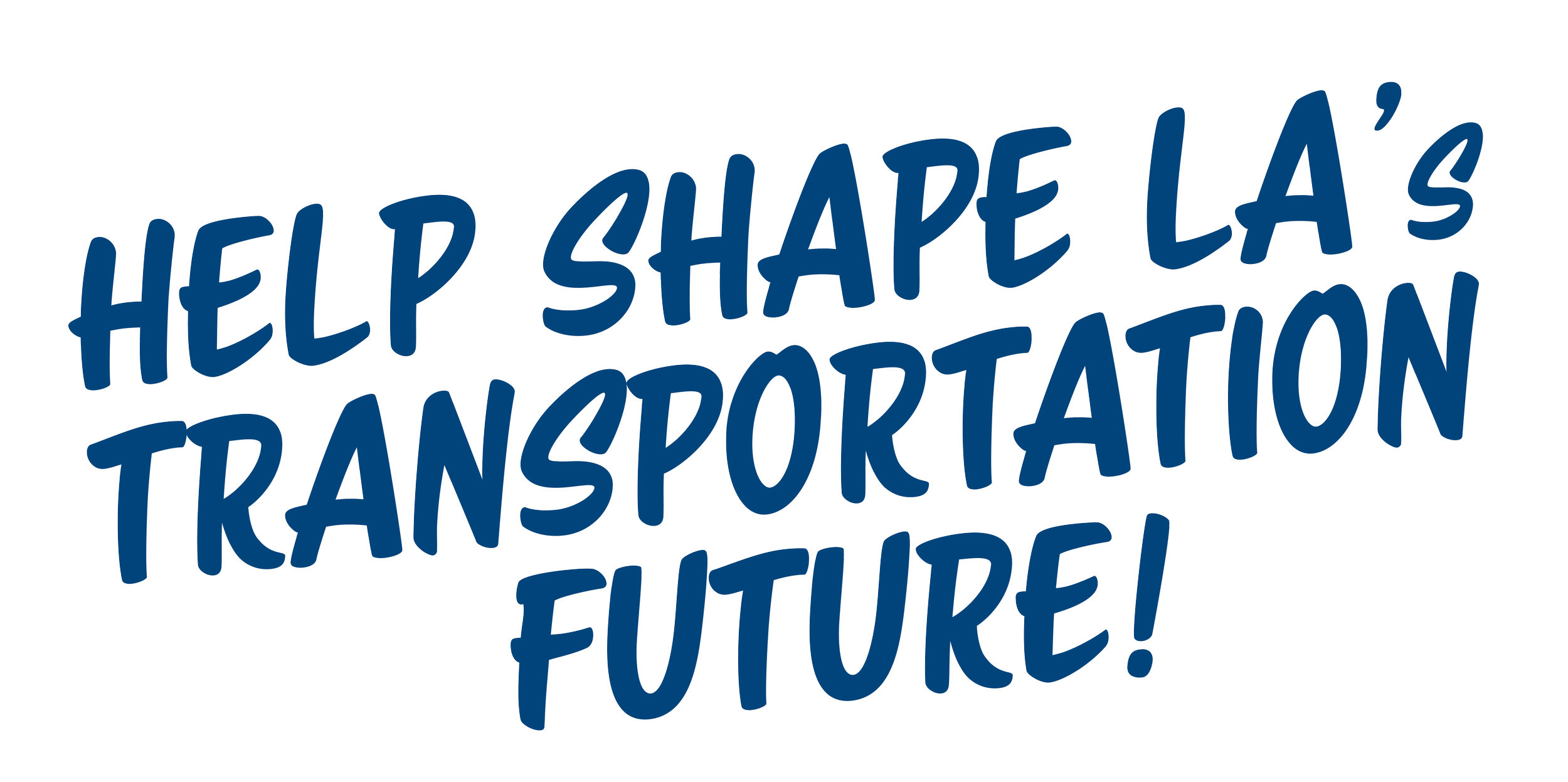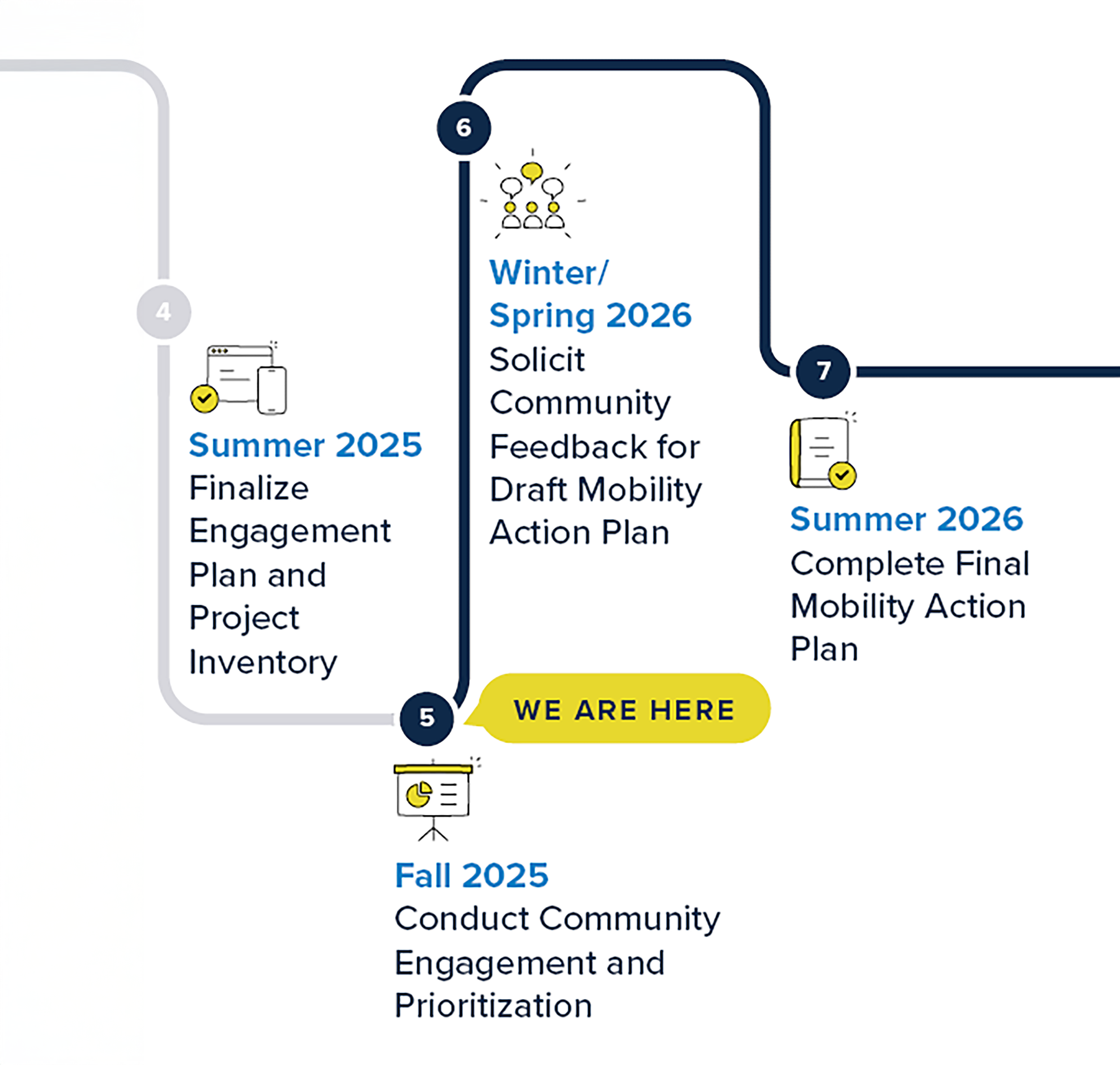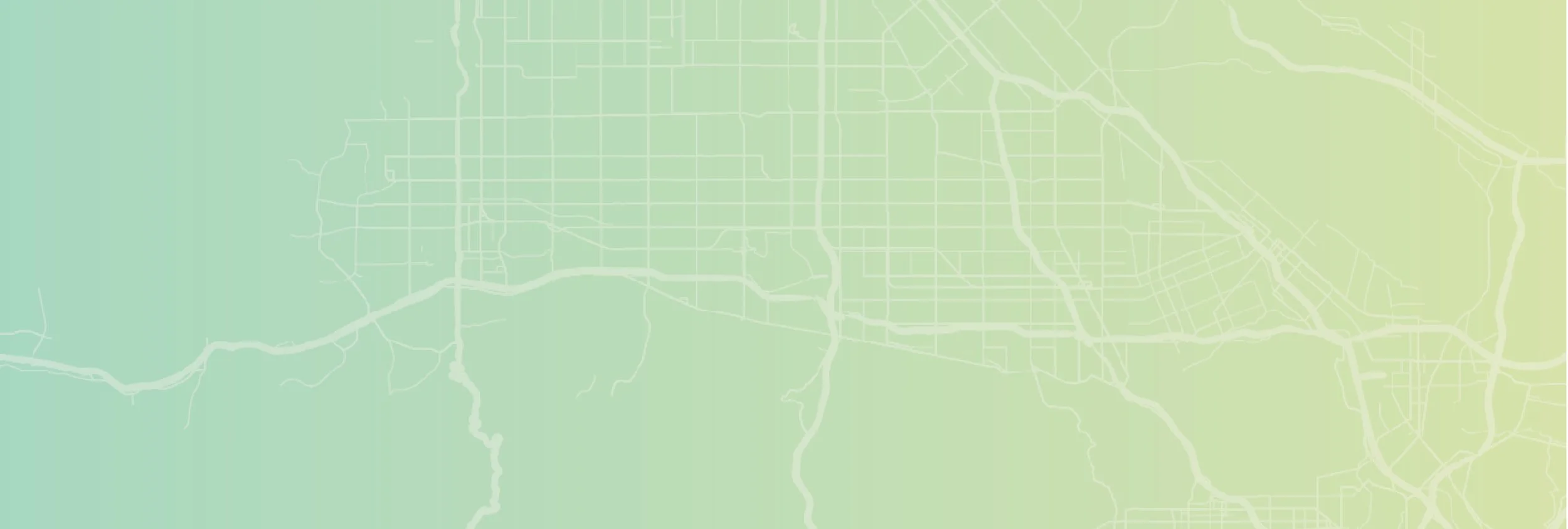
We want to hear from
YOU!
About the MAP
The Los Angeles Department of Transportation’s (LADOT) is currently developing a Mobility Action Plan (MAP) that will help the City of Los Angeles prioritize transportation investments for years to come. We are currently seeking input from all Angelenos to help shape the future of transportation in Los Angeles.
-
The MAP will produce two transportation investment plans that help the City of Los Angeles prioritize transportation projects, coordinate resources, and deliver improvements that reflect community needs and City goals. It turns values like safety, access, sustainability, and equity into tangible results.
-
The MAP sets investment priorities using a community-first engagement process and a data-driven approach, focusing on what the City can realistically deliver, when, and in what order. Investments will be prioritized in alignment with a set of principles that will guide the City towards a brighter transportation future.
-
The MAP will set out two transportation investment plans: a five-year plan with funded projects to begin in 2028, and a 20-year plan that will identify long-range capital needs and guide future mobility infrastructure investments.
-
The Mayor of Los Angeles’ Executive Directive 9 established the foundation for a citywide Capital Infrastructure Program (CIP). The CIP will serve as a multi-year framework that consolidates City capital projects into a coordinated strategy to prioritize, fund, and deliver infrastructure investments equitably across the public right-of-way. Ultimately the prioritized list of projects produced for the MAP will serve as the Mobility chapter of the first citywide CIP.
MAP Timeline

Guiding Principles and Objectives
The guiding principles serve as the foundation for the MAP’s prioritization approach to ensure that the selected projects align with the values and objectives established by the project team. Each principle includes an overall goal and objectives which will be used to help guide project prioritization.
-
Goal:
Eliminate roadway deaths and severe injuries while promoting secure, inclusive, comfortable, and consistently well maintained travel environments.
Objectives:
Focus improvements on the high-injury network.
Use design strategies that support gender-responsive safety.
Promote safe, walkable, bikeable, and rollable neighborhoods.
Improve safety and comfort for vulnerable road users like seniors, children, and people with disabilities.
Support efforts that emphasize care and shared responsibility among transportation users.
Ensure that sidewalks, crossings, bike lanes, transit stops, and other public infrastructure are consistently maintained in a state of good repair to support both safety and comfort for users.
-
Goal:
Center mobility investments on dismantling systemic barriers and promoting safe and affordable transportation options for historically underserved communities, allowing all people to travel with dignity.
Objectives:
Direct investments to neighborhoods with historic disinvestment and limited mobility access.
Eliminate financial, physical, and social barriers to mobility (e.g., cost, accessibility, safety, cultural, linguistic) for underserved communities.
Ensure inclusion of marginalized groups in decision-making.
Align investments with Universal Basic Mobility (UBM) and gender equity strategies.
-
Goal:
Ensure transportation infrastructure and services are inclusive and accessible for people of all ages, languages, and abilities.
Objectives:
Expand compliance with ADA across all modes of transportation, aiming to exceed minimum legal requirements through best practices in accessible infrastructure, vehicles, and services
Integrate universal design into the planning, design, and delivery of transportation projects to ensure systems are usable and accessible for everyone.
Address physical and functional barriers, prioritizing investments in high-need areas and connection to destinations through extended transit coverage.
Improve access to transportation-related information for seniors and limited-tech users.
-
Goal: Build a sustainable transportation network that connects people in Los Angeles to jobs, schools, services, and cultural destinations.
Objectives:
Close key gaps in multimodal networks to support walking, biking, and transit.
Ensure reliable first/last mile connections for pedestrians and bicyclists.
Support economic opportunity through access to jobs and other essential destinations.
Improve transit connectivity by increasing frequency and service reliability.
-
Goal:
Deliver transportation projects that improve public health, reduce the environmental footprint of travel, and help communities prepare for the impacts of a changing climate.
Objectives:
Expand infrastructure for zero-emission vehicles, transit, active transportation, and other low-carbon mobility options.
Reduce the number of trips made in single-occupancy vehicles and decrease total vehicle miles traveled (VMT).
Prioritize green infrastructure (e.g., street trees, shade, cool pavement) in communities experiencing extreme heat and environmental burdens.
Use public health and environmental justice data (e.g., asthma rates, heat indexes) to guide investments in high need communities.
Design transportation projects that cut emissions and reduce environmental impacts such as air and noise pollution, runoff, and urban heat.
Invest in infrastructure that helps neighborhoods adapt to climate change and build long-term resilience.
-
Goal:
Build public trust by ensuring transparent governance, consistent coordination across agencies, and community engagement that centers dignity, compassion, and respect.
Objectives:
Expand public access to transportation data, funding decisions, upcoming projects.
Standardize engagement practices across departments while tailoring them to project scale, type, and community context.
Prioritize inclusive engagement and participation in communities historically excluded from transportation planning.
Support community education and capacity building to help residents understand, navigate, and influence transportation decisions.
Strengthen interagency coordination to provide seamless, consistent public-facing communication.
-
Goal:
Funding, staffing, and timelines across departments, prioritizing maintenance and rehabilitation, and planning for long-term infrastructure needs.
Objectives:
Align funding, staffing, and readiness across departments to ensure efficient coordinated and project delivery.
Steer limited resources toward projects that offer the greatest long-term value, reduce risk, and advance shared transportation goals.
Prioritize a state of good repair through proactive asset management and timely rehabilitation of existing infrastructure.
Account for future maintenance and operational costs when evaluating new projects to ensure ongoing sustainability.
Use transparent, data-driven tools to weigh tradeoffs, inform funding decisions, and build public accountability.
MAP Projects
The final MAP will consolidate transportation projects from across the City of Los Angeles including LADOT, Public Works and many other departments. By bringing all transportation projects together into a single, coordinated framework, the MAP will provide a comprehensive list of citywide transportation investments and support more strategic, equitable decision-making.
Many City departments are responsible for delivering transportation projects in Los Angeles:
The MAP will include the following types of investments:
Better quality
sidewalks &
crosswalks
Extended time for
crossing the street
Brighter lighting & visibility on
streets/transit stops
Bike parking and
lockers
Safe walk/bike
connections to
transit stops
Speed humps &
other traffic
calming elements
Bus-only lanes to
reduce delays from traffic
Street
Repaving
Bike lanes & safer
neighborhood
streets for biking
Better bus stops & shelters (seating, shade, lighting)
Equity Priority Areas
Equity Priority Areas (EPAs) are Los Angeles communities with greater transportation needs, identified using social, economic, and environmental data. Prioritizing these areas ensures investments address inequities and support underserved residents.
Transportation Equity Index
EPAs are the communities within Los Angeles that score highest on the City’s Transportation Equity Index, which was created to support the MAP effort. The Transportation Equity Index brings together data related to demographics, access to transportation options and job opportunities, and the cost of transportation relative to household income to better understand where the highest barriers to transportation access are throughout the City.
The Transportation Equity Index was developed with the Los Angeles Community Health and Equity (CHE) Index as a key data input. The CHE aggregates data on topics including multi-modal mobility, pollution, food access, housing, health status, and demographics. The CHE was augmented with additional transportation-related data, aligned with Universal Basic Mobility concepts, to create the final Transportation Equity Index.
Central LA
South LA
Eastside Communities
Harbor Area
Northeast Valley
Existing UBM Pilot Area
Downloads
-
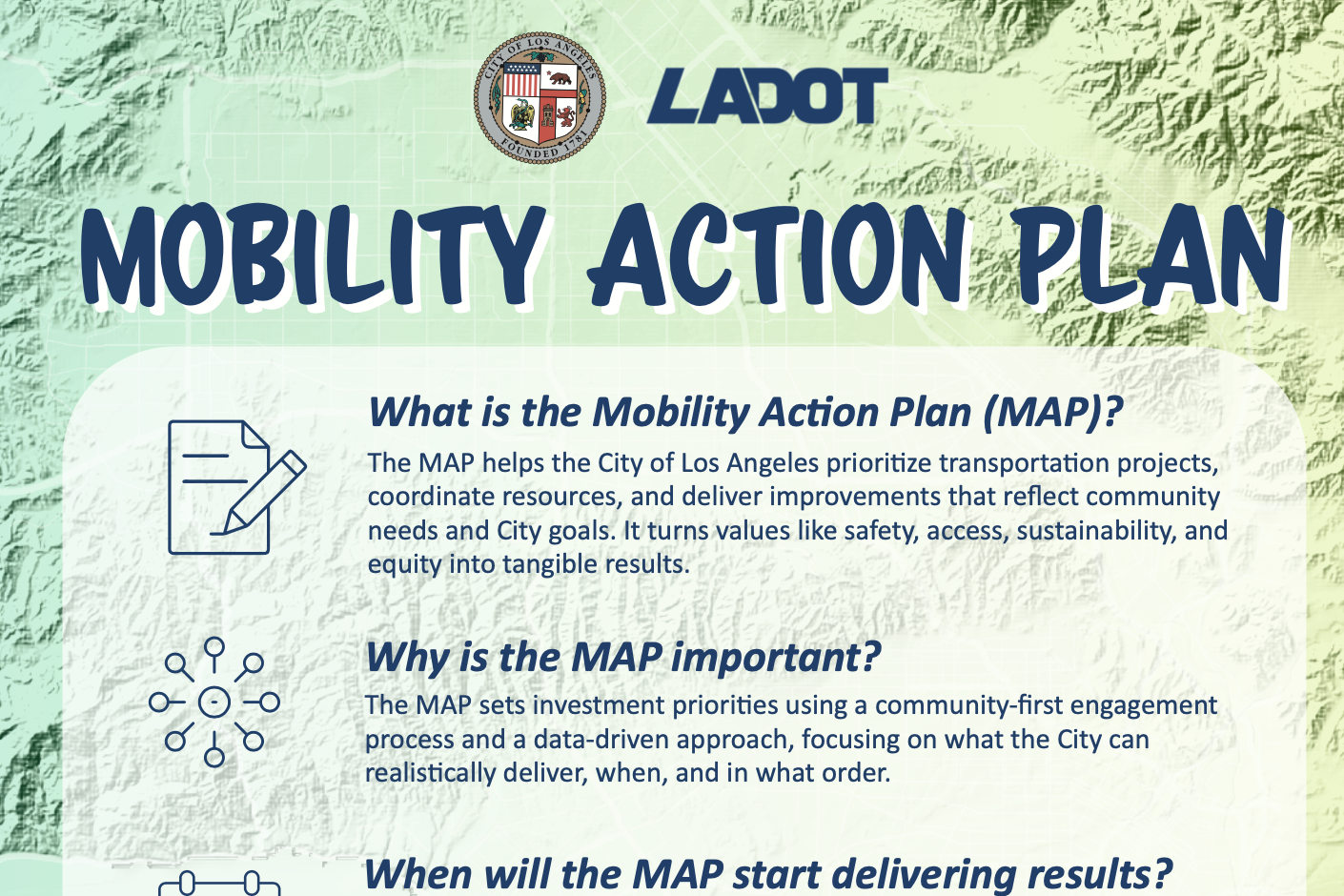
Fact Sheet
-

MAP Poster
-

Share on Social Media
